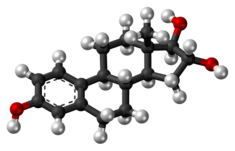
| |

| |
| Names | |
|---|---|
| IUPAC name
Estra-1,3,5(10)-triene-3,16α,17β-triol
| |
| Systematic IUPAC name
(1R,2R,3aS,3bR,9bS,11aS)-11a-Methyl-2,3,3a,3b,4,5,9b,10,11,11a-decahydro-1H-cyclopenta[a]phenanthrene-1,2,7-triol | |
| Other names
Oestriol; E3; Estratriol; Theelol; Trihydroxyestrin; Trihydroxyoestrin; 16α-Hydroxyestradiol
| |
| Identifiers | |
| |
3D model (JSmol)
|
|
| ChEBI | |
| ChEMBL | |
| ChemSpider | |
| ECHA InfoCard | 100.000.021 |
| KEGG | |
PubChem CID
|
|
| UNII | |
CompTox Dashboard (EPA)
|
|
| |
| |
| Properties | |
| C18H24O3 | |
| Molar mass | 288.387 g/mol |
Except where otherwise noted, data are given for materials in their standard state (at 25 °C [77 °F], 100 kPa).
| |
Estriol (E3), also spelled oestriol, is a steroid, a weak estrogen, and a minor female sex hormone.[1][2] It is one of three major endogenous estrogens, the others being estradiol and estrone.[1] Levels of estriol in women who are not pregnant are almost undetectable.[3] However, during pregnancy, estriol is synthesized in very high quantities by the placenta and is the most produced estrogen in the body by far,[3][4] although circulating levels of estriol are similar to those of other estrogens due to a relatively high rate of metabolism and excretion.[4][5] Relative to estradiol, both estriol and estrone have far weaker activity as estrogens.[1]
In addition to its role as a natural hormone, estriol is used as a medication, for instance in menopausal hormone therapy; for information on estriol as a medication, see the estriol (medication) article.
- ^ a b c Kuhl H (August 2005). "Pharmacology of estrogens and progestogens: influence of different routes of administration". Climacteric. 8 (Suppl 1): 3–63. doi:10.1080/13697130500148875. PMID 16112947. S2CID 24616324.
- ^ Puri (1 January 2005). Textbook Of Biochemistry. Elsevier India. pp. 793–. ISBN 978-81-8147-844-3.
- ^ a b Strauss JF, Barbieri RL (13 September 2013). Yen and Jaffe's Reproductive Endocrinology. Elsevier Health Sciences. pp. 256–. ISBN 978-1-4557-2758-2.
- ^ a b H. Maurice Goodman (14 March 2003). Basic Medical Endocrinology. Academic Press. pp. 436–. ISBN 978-0-08-048836-3.
- ^ Cite error: The named reference
(Prof.)2001was invoked but never defined (see the help page).